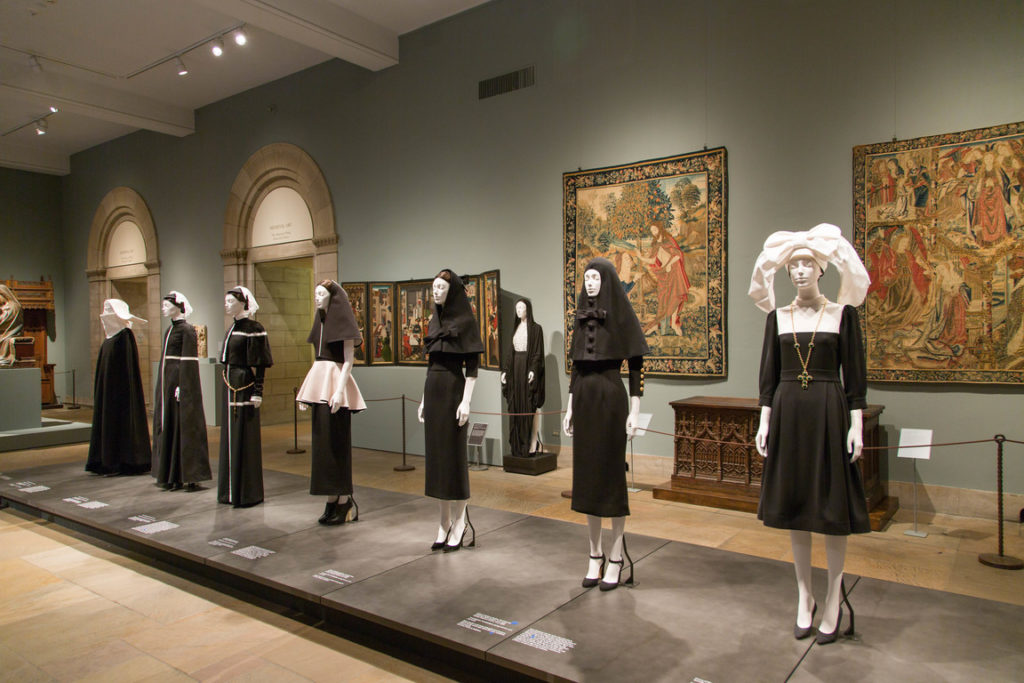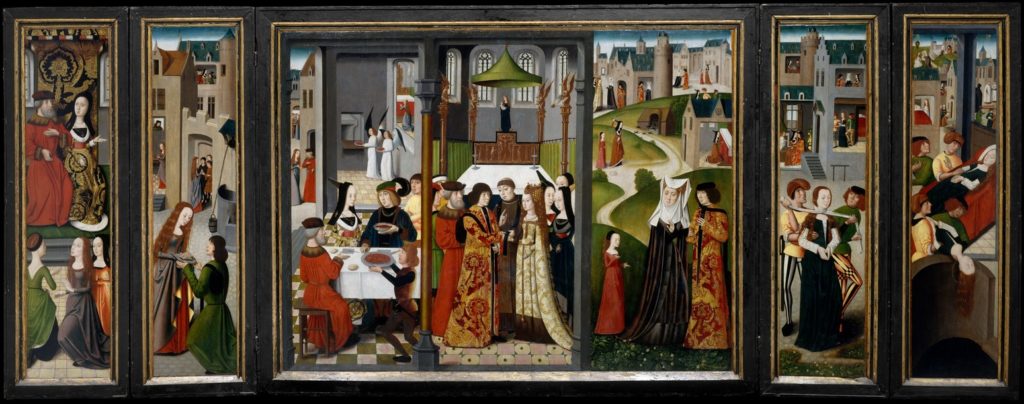Bodies are gendered; heavenly bodies may not be. That is their enticement. So, too, is their ability to generate dissonance, anxiety, and even violence.
Heavenly Bodies explores connections between fashion and the Catholic imagination. It brilliantly highlights the glory of Renaissance extravagance, most often to illuminate male hierarchy, and demonstrates that vestments, indeed, invest their wearer literally with divine powers.
The Medieval Galleries, however, uncover a different aspect of heavenly power with their focus on images of cloistered women, nuns, and the impact of the habit on contemporary fashion. These galleries offer some fascinating associations, but there is more to be discussed about the intricate historical significances of nuns, habits, convents, fashion, and art not only in the Catholic imagination, but in the American-Catholic and Protestant imagination. At heart, the focus on nuns in Heavenly Bodies highlights the historical oddness—really, the queerness—of nuns in the American imagination. It is a complex evolution that balances respect with fear, admiration with violence.1Mark S. Massa notes in Catholics and American Culture: Fulton Sheen, Dorothy Day, and the Notre Dame Football Team that until 1830 Rome, using the model of the cloister, was hesitant to allow religious houses—third orders—in the United States to engage in public service. Once it was commonly allowed the orders thrived. In 1850 there were 1344 teaching/nursing nuns in the country; in 1900 there were 30,340. The increase corresponds to the hysteria surrounding convents.

Image: © The Metropolitan Museum of Art
America has had a love/hate relationship with Roman Catholicism—often acted out on the sexless/sexualized bodies, and mediated through the European strangeness of the religious dress of the mythical nun—for more than a century and a half.
Appropriately, Heavenly Bodies opens its discussion of nuns and habits with the fifteenth-century Netherlandish polyptych The Life and Miracles of St. Godelieve (see below).Godelieve, an early second-century beautiful, yet pious, Flemish woman who desired to become a nun, was forced to marry, imprisoned, starved by her in-laws with bread and water (which she shared with the poor), and ultimately strangled and thrown into a pond (or well) to make it appear she had drowned. (In modern-day devotionals Godelieve is the patron saint of saint of in-law problems, victims of abuse, and victims of verbal spouse abuse.) The Godelieve story is, in many ways, the prototype of the conflicted American views of nuns: desexualized yet the objects of sexualized fantasies, visible yet unobtainable, self-sacrificing yet so dangerous they need to be punished.

American anti-Catholic sentiment has roots in early modern Protestantism, but took on a new, and often gendered, expression with the waves of mid-to-late nineteenth-century Catholic–Italian, Irish, Slavic, and Polish immigration. Violent anti-immigrant and anti-Catholic sentiments were embedded in the Know Nothing Party (founded 1844) and Ku Klux Klan (founded 1865). The most dramatic, best known, and deadly expressions were the 1844 Philadelphia Nativist Riots (also called the Bible Riots) that took place between May 6, 1844 and July 7, 1844. These emanated from longstanding tensions about Irish immigration, but ignited over a rumor that a Catholic superintendent of schools was going to outlaw classroom readings from the King James Bible. They caused deaths of more than twenty people and the destruction of two Catholic churches.
The fear that immigrant Catholics would provide support to Rome and the Pope to take over the United States was not confined to the Klan or Know Nothings, but played itself out over the years in mainstream politics such as the 1928 presidential contest between Catholic (“wet”) Al Smith and Protestant (“dry”) Herbert Hoover. (Their stands on prohibition were understood, by many, as religious differences.) Even as late as 1949, Paul Blanchard in his 1949 bestselling American Freedom and Catholic Power and in Communism, Democracy, and Catholic Power (1951) raised these issues in more sophisticated, secular, arguments.2Blanchard was by no means a common-variety nativist. A graduate of the University of Michigan and Harvard Divinity School he was an associate editor at The Nation for many years, and a member of the Socialist Party. After publishing American Freedom and Catholic Power (1949) he published Communism, Democracy, and Catholic Power (1951) and The Irish and Catholic Power (1954). Discussions of Catholicism in the 1960 election of John F. Kennedy, remarkably raising similar questions, in similar language, as in the Hoover/Smith election, were to a large degree shaped by Blanchard’s influential books.
Rome’s political conquest of America was the articulated threat, but haunting this were deeper anxieties. These surfaced again and again in the popular imagination as fears surrounding sex and gender, most often centered on nuns and what they symbolized. Gothic horror stories of girls enticed into, and then imprisoned in, convents, the torture of young women who try to escape, the bodies of dead infants, purported to be the children of nuns, entombed in convent walls. These stories have European roots—famously, during the reign of Pope Gregory I a rumor surfaced that 6,000 skulls of infants were found in a convent fish pond outside of Rome—and were given an active fictional life in gothic novels such as Matthew Lewis’s 1796 The Monk.3The confidence with which such horrific tales are identified as the feverish product of the anti-Catholic imagination was shaken by the discovery in 2017 of the bodies of more than 800 infants and toddlers on the grounds of the Bon Secours Mother and Baby Home in County Galway, Ireland. That there were such graves at the site was for many years dismissed as a malicious rumor.
Such fearful imaginings were magnified in predominately Protestant, and often nativist, America. To many Protestants in the United States, American nuns were an embodiment of the European gothic. The convent was the womb of heresy and sexual violation; it was the mysterious dark place—the occult—where desire cloaked in a habit violated all decent social norms. The lascivious priest—who used the confessional as a form of seduction—was the counterpart to the fantasy of de-gendered, sexually repressed, nuns.

A year later, Rebecca Reed, a woman who had voluntarily left the convent two years earlier but claimed she escaped, published Six Months in a Convent detailing her terrible life there. The book sold 200,000 copies the first month. In 1836, the anti-Catholic exploitation tract Awful Disclosures of Maria Monk, or, The Hidden Secrets of a Nun’s Life in a Convent Exposed, about life in a Canadian convent, sold enormously well in the United States. Pirated and unauthorized editions pushed sales into the hundreds of thousands within weeks. Both books, with covert and overt sexual content, functioned as anti-Catholic soft-core porn for millions for over a century–Michael Williams addresses them in the 1930s in The Shadow of the Pope: The Story of the Anti-Catholic Movement in America, as did many Catholic apologists. Their tone and perfervid imagination haunt American anti-Catholicism.
The eventual historical counterbalance to this was the American love affair with uplifting, charming, often singing, nuns promoted in post-war Hollywood starting with The Bells of St. Mary’s (1945) and Come to the Stable (1949), moving through to The Nun’s Story (1959), Lilies of the Field (1963), The Sound of Music (1965), The Singing Nun (1966), The Trouble with Angels (1966), and Sister Act (1992).
What happened? Was there a Catholic charm offensive that won over the hearts and minds of Americans through Hollywood films? Had Catholics, after years since large scale immigration started, become a salient voice in the American popular imagination? Here is where Heavenly Bodies may indicate some new ways to think about this.
That clothing is gendered is a truism. But what do nun’s habits do? Especially, historically, in a Protestant country with a sizable, growing, Catholic immigrant population quickly gaining political power. How do gender, religion, sex, and garments (vestments) play a role?
Traditional Roman Catholic garb—elaborate or plain ecclesiastical vestments, habits of religious orders, even the clerical dress and simple roman collar for a priest—has a long history of being amazing, appalling, perplexing, baffling, and ultimately sexually confusing for many US Protestants. This is, in some part, because ecclesiastical vestments for church hierarchy were, well, sexier for men than for women: they had more color, more decoration, highlighted the body, and radiated emotional theatricality. In contrast, the nun’s habits obfuscated the body, reaffirmed conformity, hinted at secrecy, and were emblematic of monastic isolation. If male vestments were almost otherworldly, nun’s habits were removed from the world. The cultural fixation on the headdress (cap, veil, wimple, coif)—the more elaborate, the more enticingly foreign—makes nuns distinctive. Sister Bertrille’s coif in The Flying Nun literally sets her apart. The extraordinariness of some coif, such as those worn traditionally by the Daughters Charity of St. Vincent De Paul (the order was founded in 1633), lend themselves to the extravagance of haute couture. Featured in Heavenly Bodies, Philip Treacy’s “Madonna Rides Again” hat (2001) is a sublime example of how variations of medieval religious dress—and most probably based on the garb of well-to-do women—can transfigure so seamlessly into theatrical elegance. By softening the angularity and introducing a graceful sweep, Treacy has feminized it for a contemporary audience. This impulse to feminize is curiously ambivalent—or ambiguous, in some cases. Treacy has worked with Grace Jones, and designed for Lady Gaga, each of whom are, in different variances, not traditionally feminine. Jones is masculine and androgynous; Gaga is hyper-femme and flirts at times with a coded trans persona. In both cases, the modern headdress, like its religious inspiration, is otherworldly.
* * *
To the non-Catholic American eye, the vestments of cardinals and popes epitomized the Renaissance; the habits of nuns, the dark Middle Ages. In a country founded on puritanism, an extreme of the Reformation, this was, at best, confusing; at worst, dangerous. When this is juxtaposed with the often blatant and sometime bewildering sexuality of Catholic iconography—a near naked St. Sebastian tied to a tree pierced by arrows, St. Agnes holding her severed breasts on a plate, St. Martin of Tours on horseback giving his cloak to the naked beggar—is it any wonder that Roman Catholicism generated, for a non-believing American public, sexual fantasy and anxiety?
Nuns inhabited a dangerous, liminal space of a distant, forbidden, almost unspoken, hint of sexuality and the maternal. Nuns are sexualized because they are gothic. (The gothic is always sexy, even when, or especially when, driven by sexual repression.) Yet, in many ways, the underlying anxiety of nuns is fear of the maternal. The language of female religious orders is parental: mother superior, mother houses, reverend mother. Ironically, they are never described as sisters, say, of Mary—whose color is blue, never black or brown—but rather, brides of Christ. Ostensibly desexualized, but never neutered, they are stern mothers: punishing, prohibitive, proscriptive. As we see in Heavenly Bodies, and noted in the catalog, many of the modern fashion incarnations of female religious habits are goth—not a surprise, as they directly emerge from the gothic. In American Freedom and Catholic Power, Blanchard, in discussing nuns as public figures and teachers, refers not to their habits but to their costumes—a perceptive remark, even if, undoubtedly, an expression of his anti-clericalism.
What does all of this history mean now in a country in which Catholics have a strong voice in public life, evangelical Protestantism is presumed by many to be the state religion, the gothic is now marketed to children (thank you, J. K. Rowling), clergy sexual abuse is discussed as a harsh reality not an anti-Catholic fantasy, and Madonna Louise Ciccone, decades ago, turned the crucifix into a fashion statement? Heavenly Bodies, in miniature, displays and embodies the history of the nun in America. The chaste, often extravagant, complicated medieval habit has become sexy fashion, and enhances sexuality, not obscures it. Black is the new black. Much of the contemporary fashion displayed here is European, but it has a very distinct, and darker, history in America.












